TS 10th Class Biology Important Questions 8th Lesson Heredity and Evolution
1 Mark Questions:
Question 1.
When cross is done between pure yellow and pure green pea seed-producing plants the following results were obtained. (Y = yellow ; y = green)?
Answer:
Answer the
Questions given below based on the above table.
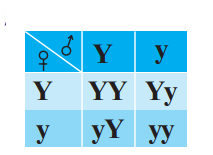
Questioni.
Yy - indicates which colour of the seed?
Answer: Yy - indicates the Yellow colour of the seed
Questionii.
What is the Phenotypic ratio of the above cross?
Answer: Phenotypic ratio of the above cross is 3: 1
Question 2.
Observe the given How-chart and answer the Question.
Who decides the sex of the baby - mother or father? How?
Answer:
 Father decides the sex of the baby.
Mother has XX chromosomes. Father has XY chromosomes.
Y chromosome is determining factor. So father is responsible
Father decides the sex of the baby.
Mother has XX chromosomes. Father has XY chromosomes.
Y chromosome is determining factor. So father is responsible
Question 3.
What examples will you give to prove that Lamarcklsm is not correct?
Answer:
Augustus Weismann, tested the theory proposed by Lamarck by experiments on rats.
He removed tails of parental rats. He observed for twenty two generations but still off springs are normal with tails
Question 4.
Which chromosomes determine the sex in human beings?
Answer:
Allosomes or Sex chromosomes. They are XX (girls) and XY (boys)
Question 5.
Why do we call appendix as a vestigial organ?
Answer:
- Vestigial organ is the organ of our body which is smaller and simpler than those in related species they have lost their original function
- Appendix is highly developed in ruminants which helps in the digestion of cellulose. But, in human beings the cellulose is eliminated as undigested food. Hence in human beings appendix has no role in cellulose digestion. So, we call it as a vestigial organ
Question 6.
What are variations?
Answer:
Differences in characters within very closely related groups of organisms are referred to as "variations"
Question 7.
What is F1 generation?
Answer:
F1 generation or first filial stands for offsprings of first generation parents
Question 8.
What is F2 generation?
Answer:
F2 generation is the offsprings produced either by self hybridization or inbreeding from F1 individuals
Question 9.
What is F3 generation?
Answer:
F3 generation represents the offsprings produced from the individuals of F2 generation
Question 10.
What is phenotyperatio?
Answer:
The characters which can be seen is known as phenotype and their ratio is called "phenotype ratio". The phenotype ratio in F2 generation of monohybrid cross is 3: 1
Question 11.
What is genotype ratio?
Answer:
The genetic makeup of an individual with reference to a specific character under consideration is called genotype and their ratio is called "genotype ratio". It indicates the internal factors. The genotype ratio in F2 generation of monohybrid cross is 1: 2: 1
Question 12.
State the law of Independent assortment?
Answer:
In the inheritance of more than one pair of characters (traits), the factors for each pair of characters assort independently of the other pairs. This is known as law of independent assortment
Question 13.
What is allele?
Answer:
The pair of genes which are responsible for character is called "allele"
Question 14.
Whatare genes?
Answer:
Genes are the factors which are responsible for character or trait of an organism.
These are the units of heredity that is transferred from a parent to offspring. These are the segments of nucleic acid called DNA which is present in the nucleus of every cell
Question 15.
What are homozygous alleles?
Answer:
Homozygous alleles are the same alleles. Either both dominant are both recessive. Ex : TT, tt
Question 16.
What is heterozygous allele?
Answer:
Heterozygous allele is that which has both dominant and recessive genes. Ex : Tt
Question 17.
What is law of dominance?
Answer:
According to Mendel, among a pair of alleles for a character, only one expresses itself in the first generation as one of the allele is dominant over the other. This is known as law of dominance
Question 18.
State the law of segregation?
Answer:
The law of segregation states that every individual possesses a pair of alleles for any particular trait and that each parent passes a randomly selected copy of only one of these to its offspring
Question 19.
What are inherited traits?
Answer:
The characters which pass from parents to children or from one generation to next generations are called "Inherited Traits" or "Inherited Characters"
Question 20.
What is heredity?
Answer:
The process of acquiring characters or traits from parents is called "Heredity"
Question 21.
What is Inheritance?
Answer:
The process in which traits are passed from one generation to another generation is called "Inheritance"
Question 22.
What are autosomes?
Answer:
Chromosomes whose number and morphology do not differ between males and females of a species are called autosomes
Question 23.
What are allosomes?
Answer:
Sex determining chromosomes are called allosomes or sex chromosomes. in humans there is a pair of allosomes. There are two types of allosomes in human, one is X and second one is Y
Question 24.
What are acquired characters?
Answer:
Characters that are developed during the lifetime of an organism are called "acquired characters"
Question 25.
What is inheritance of acquired characters?
Answer:
Lamarck proposed that the acquired characters are passed to its offspring. i.e. to next generation. This Is known as "Inheritance of acquired characters". For example elongation of neck and forelimbs in giraffe
Question 26.
What is meant by survival of the fittest?
Answer:
Nature favours only useful variations. Each species tend to produce large number of offspring. They compete with each other for food, space, mating and other species. In this struggle for existence, only the fittest can survive. This is called survival of the fittest
Question 27.
What is micro evolution?
Answer:
Small changes within the species is known as micro evolution
Question 28.
What is macro evolution or speclation?
Answer:
The process of evolution through which new species are going to be formed is known as speciation or macro evolution
Question 29.
What are homologous organs?
Answer:
Organs which have a common fundamental anatomical plan and similar embroyonic origin whatever varied functions they may perform are called homologous organs. Ex: Flippers of a whale, wing of a bat, forelimb of a horse, forelimb of human
Question 30.
What are analogous organs?
Answer:
Analogous organs are those that perform similar functions but have entirely different embryonic origins.
Ex : Wing of a bird and wing of a bat
Question 31.
What is embryology?
Answer:
Embryology is the study of the development of an organism from egg to adult stage
Question 32.
What are fossils?
Answer:
Fossils are evidence of ancient life forms or ancient habitats which have been preserved by natural processes
Question 33.
What is Palaeontology?
Answer:
The study of fossil is called "Palaeontology"
Question 34.
What is the method used to determine the age of the fossil?
Answer:
Carbon dating is the method used to determine the age of the fossil
Question 35.
What is human evolution?
Answer:
Human evolution is the evolutionary process leading up to the appearance of modern human beings
Question 36.
How do variations occur?
Answer:
Variations dey lop during reproduction In organisms. Sexual reproduction and errors in DNA copying lead to variations in offspring in a population
Question 37.
What is divergent evolution?
Answer:
The evolutionary process through which homologous organs develop is called divergent evolution
Question 38.
What is convergent evolution?
Answer:
The evolutionary process through which analogous organs develop is called convergent evolution
Question 39.
Where were the fossils of dinosaurs collected in our state from?
Answer:
The fossils of dinosaurs and ketosaurs were collected from Yamanapalli in Adilabad district in Telangana state
Question 40.
What are vestigial organs?
Answer:
Organs which are not useful in animal are called vestigial organs
Question 41.
Who was the first person to propose the theory of evolution?
Answer:
Jean Baptist Lamarck was the first person to propose the theory of evolution
Question 42.
Who proposed the theory of Inheritance of acquired characters?
Answer:
Jean Baptist Lamarck proposed the theory of Inheritance of acquired characters
Question 43.
Who proved that the bodily changes which may occur due to environment wont be passed to its offsprings?
Answer:
Augustus Weismann proved that the bodily changes which may occur due to environment wont be passed to its offspring
Question 44.
Who proposed the theory of Natural selection?
Answer:
Charles Darwin proposed the theory of Natural selection
Question 45.
What does the theory of Natural selection state?
Answer:
The theory of Natural selection states that nature only selects which organism should survive or perish in nature. The organisms with useful traits will survive. The organisms having harmful traits are perished or eliminated from its environment
Question 46.
How many vestigial organs are there in human beings?
Answer:
There are nearly 180 vestigial organs in human beings
Question 47.
Give some examples for vestigial organs in man?
Answer:
Pinna, hair on skin, mammary glands in man, appendix, etc. are the examples for vestigial organs
Question 48.
Which organism is said to be a moving museum of vestigial organs?
Answer:
Human being is said to be a moving museum of vestigial organs
Question 49.
How can one change adopted perform different functions?
Answer:
The study of evolution reveals one change occurred initially is used to perform other function. For example initially feathers were evolved for warmth, later they were adapted for flight
Question 50.
Why are traits acquired during the lifetime of an individual not inherited?
Answer:
Any change in somatic cells cannot be passed to DNA of germ cells. Hence these traits are not inheritable
Question 51.
What factors could lead to rise of a new species?
Answer:
- Genetic variation
- Natural selection
- Genetic drift
Question 52.
Can the wing of a butterfly and the wing of a bat be considered homologous organs? Why or why not?
Answer:
No, though the function of wings in both the cases is same they are structurally different and their origin is also different. They are analogous organs
Question 53.
If the sperm bearing Y chromosome fertilizes the egg, the child born will not be entirely like his father, why is it so?
Answer:
It is because the other sex chromosome, i.e. X- chromosome also has its effect on the fertilized egg
2 Mark Questions:
Question 1.
Is variation all about apparent differences ? Or is it about some subtle differences as well that we most often overlook?
Answer:
- Variations are not always apparent differences
- Sometimes these may be subtle differences that we most often overlook
- When these subtle differences accumulate together they may become apparent
Question 2.
How do parent plants pass on their traits to the seeds?
Answer:
- Every character or trait is controlled by a pair of factors called genes
- At the time of sexual reproduction one factor or each trait will pass to the gametes
- By the fusion of male and female gametes zygote will form in which factors from both male and female parents get paired again
- This zygote will develop into seed in the later stages
- Thus parent plants pass on their traits to the seeds
Question 3.
Will the seeds from tall plants always produce new tall plants?
Answer:
- No. Tall plants may or may not produce tall plants again
- This is because tallness is a dominant character in most of the plants especially in peas
- So tall plant may be homozygous tall (TT) or heterozygous tall (Tt)
- If the parental plant is homozygous tall (pure breed), then they always produce new tall plants
- If the parental plant is heterozygous tall plant, then they produce the tall and dwarf plants in the ratio of 3: 1
Question 4.
Who decides the sex of the baby - mother or father?
Answer:
- Sex determination of the baby depends on the sex chromosome carried by the sperm, as the ovum always carries X chromosome only
- If the sperm with X chromosome fuses with ovum, the baby will have XX condition. So he baby will be a girl
- If the sperm with Y chromosome fuses with ovum, the baby will have XY condition. So the baby will be a boy
- So the sperms that come from father decides the sex of the baby
- In fact it is by mere chance and the chance for any sex formation is 50% as the male produces both sperms with X and sperms with Y are produced in same number
Question 5.
How does the evolution of organisms take place?
Answer:
- Variations which are beneficial are selected by the nature and passed from parents to offspring through heredity
- The same process happens with every new generation until the variation becomes common feature
- As the environment changes, the organism within environment adapts and changes to the new living conditions
- Over a long period of time, each species of organisms can accumulate so many changes that it becomes a new species
- Thus evolution of organisms took place from common pre-existing ancestors
Question 6.
Think why ancient human beings travelled from one place to other and how they travelled?
Answer:
- Ancient human beings travelled from one place to other in search of better living conditions such as availability of food, water and other facilities
- They did not travel in a single line
- They went forwards and backwards with groups, sometimes separating from each other
- This travel is responsible for the formation of races
Question 7.
Explain the theory of "inheritance of acquired characters" with an example?
Answer:
- Jean Baptist Lamarck proposed the theory of inheritance of acquired characters
- According to this theory the new character that are developed during the life time of an organism are passed to next generation
- For example initially giraffee was equal to deer. Due to shortage of food materials and to reach the lower branches of tree giraffee started stretching its neck
- Because of continuous stretchness of neck after several generations giraffee developed long neck
- Such character that are developed during the life time of an organism are called acquired characters. These acquired characters are passed to next generation
Question 8.
Who decides the sex of the baby, mother or father Explain with a flow chart?
Answer:
Father decides the sex of the baby.
(Or)
Draw a flow - chart showing the sex determination in human beings.
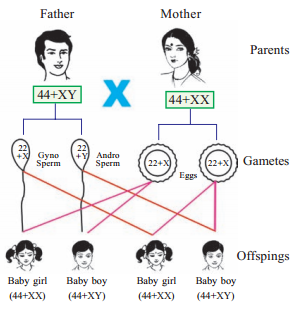
Question 9.
Define the terms phenotype and genotype?
Answer:
Phenotype: The observable properties of an organism that are produced by the interaction of the genotype and the environment. These characters can be seen.
Genotype : The genotype is the genetic make-up an individual usually with reference to a specific characteristic consideration
Question 10.
What Questions you will ask a palaeontologist about fossils?
Answer:
- What are fossils
- How do they preserve
- What can be the actual remains
- How do they form
- What do we call the study of fossil
- Can you tell some examples of fossils
- Flow do the palaeontologists determine the age of fossils
- What are dinosaurs and ketosaurs ? In which years they belong
- Where did they collect the fossil of dinosaurs ? What is the length of this fossil
- Where did they preserve the fossil of dinosaurs
Question 11.
Observe the checker board and answer the following Questions?
- Write phenotypic ratio of monohybrid cross
- How many heterozygous plants are present in the checker board
Answer:
- Phenotypic ratio 3: 1
- Two heterozygous plants
Question 12.
How does the embryological evidences support that Evolution has taken place?
Answer:
Evidences:
- Remarkable similarities in the Embryos of different animals from fish to man
- Tadpole of frog resembles the fish more than the frog
- Life history of every individual exhibits the structural features of their ancestors
- The resemblance is so close at an early stage, it is difficult to distinguish one embryo from other
Question 13.
What happens if there is no evolution?
Answer:
- Evolution is a continuous and comprehensive process
- If it does not take place, there is no formation of new species
- Variations do not take place and hence desirable traits are not developed
- All the Earth would be with the primitive species without any changes
Question 14.
If you cross a plant with pure yellow seeds (YY) with a plant with pure green seeds (yy), what would be the colour of the seeds in F2 generation ? Show in a checker board?
Answer:
 All pea plants are yellow in F1 generation on self pollination in F1 generation
All pea plants are yellow in F1 generation on self pollination in F1 generation
 In F2 generation, we can observe that 75% are yellow seed producing pea plants and 25% are green ones.
Hence the phenotypic ratio is 3: 1 the genotypic ratio is 1: 2: 1
In F2 generation, we can observe that 75% are yellow seed producing pea plants and 25% are green ones.
Hence the phenotypic ratio is 3: 1 the genotypic ratio is 1: 2: 1
4 Mark Questions:
Question 1.
Explain sex determination in humans with the help of flow chart?
Answer:

- Each human cell contains 23 pairs (46) of chromosomes
- Out of 23 pairs, 22 pairs of chromosomes are called autosomes
- Remaining one pair is called allosomes or sex chromosomes
- There are two types of sex chromosomes - one is X and the other is Y
- These two chromosomes determine the sex of an individual
- Females have two X chromosomes in their cells (XX)
- Males have one X and one Y chromosomes in their cells (XY)
- All the gametes produced by women (ovum) will be with only X chromosomes
- The gametes produced by man (sperm) will be of two types, one with X chromosomes and other with Y chromosomes
- If the sperm carries X chromosome and fertilizes with the ovum, the resultant baby will have XX condition. So the baby will be a girl
- If the sperm carries Y chromosome and fertilises with the ovum, the resultant baby will have XY condition. So the baby will be a boy
Question 2.
What are Mendels laws of inheritance? What are the reasons to choose pea plant for his experiment?
Answer:
Mendels Laws of inheritance
- Law of Dominance : Among a pair of closely related alleles or factors, only one expresses itself. In the first generation as one of the allele is dominant over the other. This is called as Mendels Law of dominance
- Law of Seggregation : The law of seggregation states that every individual possesses a pair of alleles for any particular trait that each parent posses a randomly selected copy only one of these to its off-spring
- Law of Independent assortment: In the inheritance of more than one pair of characters (traits), the factors for each pair of characters assort independently of the other pairs. This is known as Law of Independent assortment
Mendel has chosen garden pea as material for his experiment because:
- It has well developed characters
- It is a bisexual flower
- Predominently self pollinating
- Suitable for cross pollination
- It is an annual plant
Question 3.
What is Phenotype and Genotype? Explain them with the help of Mendels Monohy brid cross?
Answer:
Phenotype: Expression of visible character of an individual is called phenotype.
Genotype: Genetic constitution of an individual for any character is called Genotype or Probable nature of factors is known as genotype.
Cross Pollinating a pure breed of yellow coloured pea seeds (YY) and green coloured pea seeds (yy) give F1 generation. All pea seeds were yellow in F1 generation. So, yellow colour is phenotype. Yy is genotype of all pea seeds in F1 generation.
 F2 Generation: Self pollination of F1 pea plants Yy
F2 Generation: Self pollination of F1 pea plants Yy
 Phenotype Ratio is 3:1 Genotype Ratio is 1:2:1
Phenotype Ratio is 3:1 Genotype Ratio is 1:2:1
Question 4.
Explain in brief any two evidences of Evolution?
Answer:
Some of the evidences of evolution are
- Homologous and analogous organs
- Evidences from embryology and
- Evidences from fossils
I. Homologous and analogous organs:
- Organs which have common fundamental anatomical plan and similar embryonic origin, whatever varied functions they may perform are regarded as homologous organs
- For example forelimb of a whale, wing of bat, leg of leopord, claw of mole and hand of man
- They indicate that all the vertebrates are evolved from common ancestor
- Organs which are structurally different but functionally similar are known as "Analogous organs"
- For example wings of bats and wings of birds
- The designs of the two wings, their structure and components are different but they look similar because they have a common use for flying but their origin is not common
II. Evidences from embryology:
- There are remarkable similarities in the embryos of different animals from fish to man
- The resemblance is so close that at an early stage even an experienced embryologist would find difficulty to distinguish one embryo from the other
- This strengthens the view of the existence of a common ancestor from which all these have evolved
III. Evidences from fossils:
- Fossils are evidences of ancient life forms or ancient habitats which have been
preserved by natural processes
- Palaeontologists determine the age of fossils by using carbon dating method
- These fossils provide evidences of presence of extinct animals like dinosaurs and how the evolution occurred on the earth, etc
Question 5.
Observe the given flow-chart and answer the following Questions?
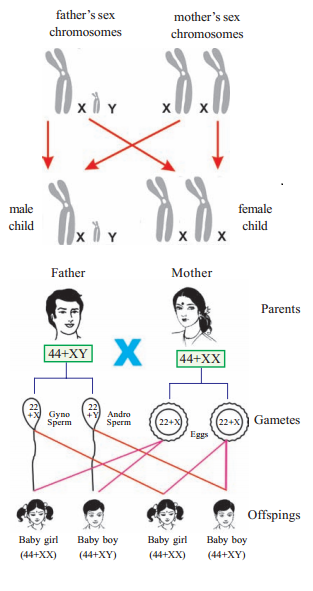
Questioni.
Name the chromosomes that determine the sex of an individual?
Answer:
Y Chromosome of father
Questionii.
Show given Information in the form of Checker Board?
Answer:
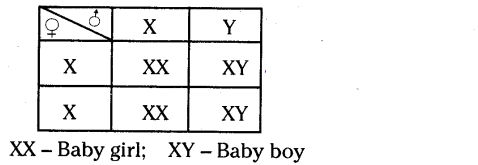
Questioniii.
In this situation, which principle of Mendel Is applicable?
Answer:
Law of dominance
Questioniv.
"Mother determines the sex of the baby". Is this statement correct or not? Why?
Answer:
The statement is not correct. Because the sperm of father that carries Y chromosome fertilize with ovum of mother that contains X chromosome the resultant will be XY - Male baby
I. Conceptual Understanding
Question 1.
Keep in mind Mendels experiments and write what you know about the following?
- Pure breed
- Phenotype
- Genotype
- Alleles
Answer:
- Pure breed : These are such kind of plants that expresses a selected character, over several generations. Such plants according to Mendel were pure breed for that character
- Phenotype: The characters which can be seen is known as phenotype. We cannot determine the internal factors by phenotype. It tells about only the dominating characters which express externally. The phenotype ratio in monohybrid cross is 3: 1
- Genotype : The genetic make up of an individual is known as genotype. Genotype itself is the indication of internal factors. It tells about both dominant and recessive characters present within. The genotype ratio in monohybrid cross is 1: 2: 1
- Alleles: Alleles are corresponding pairs of genes located at specific positions in chromosomes. Together they determine the genotype of their host organism. Every individual possesses a pair of alleles for any particular trait and that each parent passes a rondomly selected copy of only one of these to an offspring. The offspring then receive their own pair of alleles for that trait one each from both parents
Question 2.
What is natural selection? How does it direct the evolution ? Explain with an example?
Answer:
- Natural selection states that nature only selects or decides which organism should survive or perish in nature
- The organisms with useful traits will survive and the organisms having harmful traits are going to be perished or eliminated from its environment
- Let us consider a group of red beetles which live in bushes on green leaves and grow by sexual reproduction
- Let us assume crows eat these red beetles
- Let us consider one colour variation arises during reproduction so that there is abeetle that is green in colour instead of red
- Moreover, this green colour beetle passes its colour to its offspring, so that all its progeny are green
- Crows cannot see the green coloured beetles on green leaves of the bushes and therefore crows cannot eat them
- But crows can see the red beetles and eat them
- As a result, there are more and more green beetles than red ones which decrease their number
- The variation of colour of beetle green gave a survival advantage to green beetles than red beetles
- In other words, it was naturally selected by means of crows
- The more crows there are, the more red beetles would be eaten and the more number of green beetles in the population would be. Thus the natural selection is directing evolution in the beetle population
Question 3.
What is genetic drift ? Explain how it provides diversity in the population?
Answer:
- Changes in the frequency of genes in small populations, due to accidents is known as "Genetic drift"
- Let us consider a colour variation occurred in red colour beetles which are living on green coloured leaves of bushes
- It results in "blue" colour beetles instead of red colour beetles and passed its colour to its progeny
- Initially in the population, there are few blue beetles, but most are red
- Imagine at this point, an elephant comes by and stamps on the bushes where the beetles live
- This kills most of the beetles but by chance a few beetles survived are mostly blue
- Again the beetle population slowly increases, but in the beetle population most of them are in blue colour
- Thus genetic drift provides diversity in the population
Question 4.
Write the main points in the Darwin theory of evolution in a nutshell?
Answer:
Darwins theory of evolution in a nutshell
- Any group of population of an organism contains variations and not all members of group are identical
- Variations are passed from parent to offspring through heredity
- The natural selection over abundance of offspring leads to a constant struggle for their survival in any population
- Individual organisms with variations that help them to survive and reproduce tend to live longer and have more offsprings than organisms with less useful features
- The offsprings of survivors inherit the useful variations, and the same process happens with every new generation until the variation becomes a common feature
- As the environment changes, the organism within the environment adapts and changes to the new living conditions
- Over a long period of time, each species of organism can accumulate so many changes that it becomes a new species, similar to, but distinctly different from the original species. All species on the earth arise in this way
- Evolution is a slow and continuous process
Question 5.
How are new species evolved?
Answer:
- Sexual reproduction and errors in DNA copying leads to variations in offspring in a population
- Organisms contain variations that help to adapt to its environment going to be survived more efficiently
- But in the same population, the organisms which contain the trait which may not help to adopt in its environment may be perished or eliminated slowly
- These small changes within the population due to variations is called micro evolution
- When organisms of the same species with variations are separated by some cause for long years, lot of variations may take place in these years
- These accumulated variations make them unable to mate and produce new offsprings
- Thus new species form and this is known as speciation or macro evolution
Question 6.
What are fossils ? Write a short note on their formation?
Answer:
- Fossils are evidence of ancient life forms or ancient habitats which have been preserved by flatural processes
- Fossil evidence is typically preserved within sediments deposited beneath water and land
II. Asking Questions And Making Hypothesis
Question 1.
What is meant by law of dominance ? To know more about law of dominance, what kind of Questions will you ask?
Answer:
- Out of a pair of contrasting characters present together only one is able to express itself while the other remain suppressed is known as law of dominance
- I will ask following
Questions to know more about law of
dominance:
- Who proposed law of dominance
- Which plant Mendel took for his experiments
- Why he (Mendel) took pea plant for his experiments
- How many contrasting characters he choose in pea plant
- How can you correlate law of dominance in daily life situation
- Tall / dwarf - which one is dominant character
(You can add some more Questions related to concept )
Question 2.
What are the hypothesis assumptions and outcomes of Mendels experiments with pea plants?
Answer:
Regarding his experiments with pea plants, Mendel hypothesised that
- Characters were carried as traits and an organism always carried a pair of factors for a character
- The distinguishing traits of the same charater were present in the population of an organism
- The traits shown by the pea plants must be in the seeds that produced them
- The seeds must have obtained by the traits from the parent plants
His assumptions made to explain his observations are:
Assumption 1: Every pea plant has two factors which are responsible for producing a particular property or trait.
Assumption 2: During reproduction one factor from each parent is taken to form a new pair in the progeny.
Assumption 3: One of these will always dominate the other if mixed together
Laws made from his experiments:
- Law of Dominance : Among a pair of alleles for a character, only one expresses itself in the first generation as one of the allele is dominant over the other
- Law of Segregation : Every individual possesses a pair of alleles for any particular trait and that each parent passes a randomly selected copy of only one of these to its offspring
- Law of Independent Assortment: In the inheritance of more than one pair of characters the factors for each pair of characters assorts independently of the other pairs
III. Experimentation And Field Investigation
Question 1.
The cross between Hybrid tall (Tt) and dwarf (tt), what will be F1 generation progency. Write phenotypic and genotypic ratio?
Answer:
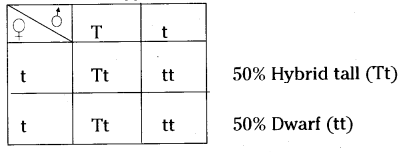 Phenotype ratio 1: 1
Genotype ratio 1: 1
Phenotype ratio 1: 1
Genotype ratio 1: 1
Question 2.
What will be phenotypic and genotypic ratio if cross between pure Red (RR) and Hybrid Red (Rr)?
Answer:
Parents are RR and Rr.
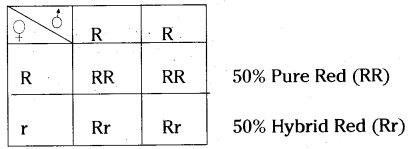 Phenotypic ratio 2 : 0
Genotypic ratio 1: 1: 0
Phenotypic ratio 2 : 0
Genotypic ratio 1: 1: 0
V. Communication Through Drawing, Model Making
Question 1.
Draw the diagram of monohybrid cross and explain it?
Answer:
A cross-pollination between a pure breed of yellow seed bearing plant and green seed bearing plant gave the following results:
First Filial / F1-generation : (Filial means progeny)
All pea seeds were Yellow. On self-pollination of these pea plants the following results were obtained :
All pea seeds were yellow
Second Filial / F2-generation : The F2 generation had about 75% of yellow seeded pea plants and 25% of green seeded pea plants, i.e. they appear in 3: 1 ratio
Adding to above results, Mendel made following observations:
- A set of peas (about 25%) obtained in F2 generation are yellow seeded plants (Hornozygous dominant)
- A Set of peas (about 50%) obtained in F2 generation are heterozygous yellow and give yellow and green seeds in 3:1 on self pollination
- A set of peas (about 25%) obtained in F2 generation are green seeded. On self-pollination they keep producing green seeded plants (Homozygous recessive)
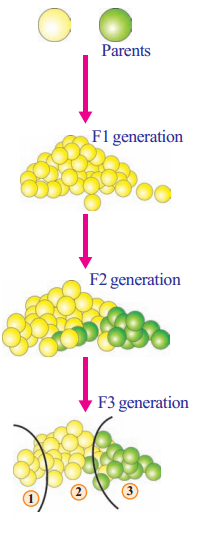
VI. Apprecition Andthetic Sense, Values
Question 1.
How will you appreciate Mendels work?
Answer:
- Mendel laid foundation to hybrid varies in plants
- Because his works and laws (Mendels laws) became guide to later generation scientist
- So many plants with desirable characters created, which are helpful to mankind
- His works help the scientist to find new varieties of species in animals
- Ultimately more desirable plants and animals came into existence
Question 2.
How would you appreciate Gregor Johann Mendels contribution to the genetics?
Answer:
- Gregor Johann Menclel worked on the problem of how variations were passed from one generation to the other
- As he was a monk, he did his experiments with interest in the garden of the monastery
- He worked for over seven years alter which he presented conclusions from his experimental data in a form of a detailed research paper
- Mendel made many careful observations of pea plants and asked himself
Questions about what he observed and then planned and designed experiments to find the answers
- He had worked on nearly 10,000 pea plants of 34 different varieties choosing 7 distinguishing forms of characters
- His experimental outcomes gave the idea how the variations were passed on from one generation to another
- He was an exemplary person for his observation, planning, patience and experimental skills
- His efforts to know the secrets of nature was really appreciable
Question 3.
How would you appreciate Charles Robert Darwin for his work on evolution?
Answer:
- Charles Darwin voyaged for five years, just when he was 22 years old
- In the world survey ship H.M.S. Beagle, he visited number of places including Galapagos Islands
- He keenly observed the flora and fauna of these places
- He gathered a lot of information and evidences
- He was influenced by the book "Principles of Geology" written by Sir Charles Lyell and "Maithus theory written in "An essay on the principles of population"
- Darwin proposed the theory of "Natural selection", means nature only selects or decides which organism should survive or perish in nature
- This theory remained a milestone in the studies of evolution
- Everyone should appreciate him for his observations and analytical abilities which revealed the secret from where we come from
VII. Application To Daily Life, Concern To Biodiversity
Question 1.
Write a small essay supporting fila t genes are the cause to form to different characters in organisms?
Answer:
A gene is the section of DNA on a chromosome which controlls a specific characteristic of the organism. A gene is a unit of DNA on a chromosome which governs the synthesis of one protein that controls a specific characteristic of an organism. There are thousands of genes on a chromosome which control various characteristics of an organism
Genes are actually units of heredity which transfer characteristics from parents to their offsprings (luring reproduction. Genes work in pairs. Genes controlling the same characteristics are given the same letters. For example the gene for tallness is represented by the latter T whereas the gene for dwarfness is represented by the letter t
Genes for controlling the same characteristics of an organism can be of two types dominant or recessive. The gene which decider the appearance of an organism even in the presence of an alternative gene is known as dominant gene. The gene which can decide the appearance of an organism only in the presence of another identical gene called recessive gene
Question 2.
Sujathas in-laws worried for having daughter in her second delivery. How will you make them agree that she is not all responsible for having daughter?
Answer:

- Sujatha is not responsible for giving birth to female child. Men are responsible for the birth of male / female child
- Each human cell contains 23 pairs of chromosomes. Out of 23 pairs, 22 pairs of chromosomes are autosomes
- The remaining pair is called allosomes or sex chromosome. These are two types; one is X and the other is Y. These two chromosomes determine the sex of individual
- Females have two X chromosomes in their cells (XX). Males have one X and one Y chromosome in their cells (XY)
- All the gametes produced by woman have only X chromosomes. The gametes produced by a man are of two types one with X chromosome and other with Y chromosome
- If the sperm carries Y chromosome and fertilizes the OVU (X chromosome). Then the baby will have XY condition. So the baby will be a boy